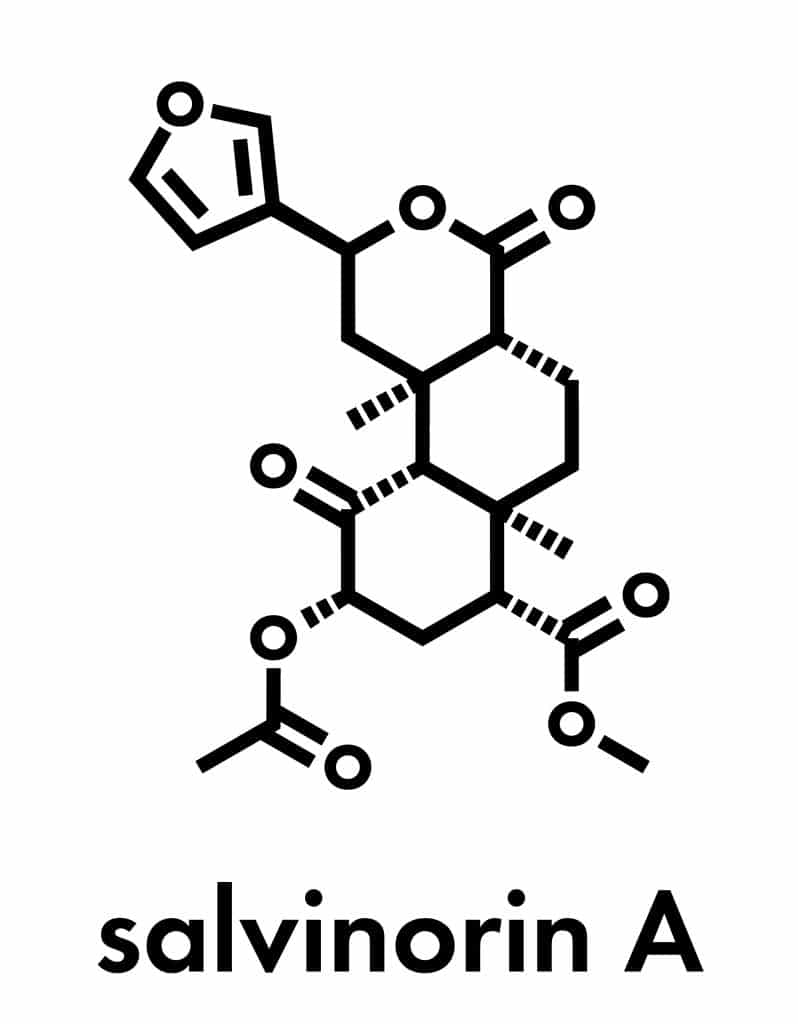The plant salvia proposes an interesting situation in that it’s a hallucinogenic plant, that remains legal in the US. As more states and individual locations loosen laws against entheogenic plants, their acceptance, and the ability for a market, gets wider and wider. For something like salvia, no legalization must be made, meaning once producers feel like getting products out there, you can buy them. In terms of what salvia feels like, here’s what the people have to say.
What is salvia?
Salvia divinorum is a plant species that originated in the Sierra Mazateca cloud forests of Oaxaca, Mexico. This climate is perfect for the plant that loves shade and moist conditions. Interestingly, some believe this might not be the actual location of origin, and that it could have been brought over by other tribes, from some other unknown location. At this point, it’s hard to know for sure.
These days it can be found in more places, and is common to many regions of the US. Though it certainly has more name value than other lesser known psychoactive plants, a recent study found that when it comes to salvia, only about 5% of the people of the US say they’ve used it. That was, however, a small scale study.
You might be familiar with the name ‘salvia’ in a different context. Salvia officinalis is the name for the ubiquitous kitchen spice ‘sage’, which is a sister species to the psychoactive Salvia divinorum. Both of these species, as well as others (like Salvia rosmarinus – rosemary), come from the Lamiaceae mint family. Salvia divinorum is not the only one of the family to produce hallucinations, as any other species with the compound salvinorin A will do so.
Thanks for coming by. For product promotions, and updates to your email, subscribe to the Cannadelics Weekly Newsletter. You’ll get access to deals on cannabis flowers, vapes, edibles, smoking devices, cannabinoid compounds (like HHC, delta-8), and so much more. Take a look at the options: Get stoned responsibly!
The name Salvia divinorum represents these hallucinogenic abilities. ‘Divinorum’ comes from the word ‘divination’, and is translated to “diviner’s sage” or “seer’s sage.” It was used by the Mazatec shamans for hundreds of years in spiritual healing and divination. It was used to induce hallucinations and altered states of consciousness, and is still used in this way today. Shamans use fresh leaves to represent the Virgin Mary, and begin rituals with invocations to her and other saints. It must be quiet to use salvia, as its said Mary speaks with a quiet voice.
Salvia also has medical benefits, and is used in the treatment of diarrhea, anemia, headaches, and rheumatism; as a diuretic; and to treat ‘swollen belly’.
In the US, since it wasn’t around at the time that other hallucinogenic drugs like LSD and magic mushroom were made illegal, it retained legality, much like Amanita mushrooms. In other countries like Estonia, Finland, Iceland, and Norway, its used as a medicine that requires a prescription; while much of Europe has regulation making it illegal. In Russia, the possession is legal, but not sale; and in Chile, France and Spain, the possession and cultivation of the plant is legal, but selling it is not. The US federal government never scheduled salvia, but 13 states did enact legislation to ban it.
The effects of salvia
The plant gives hallucinogenic effects through the compound salvinorin A; which is classified as a diterpenoid. It has a different structure then most other hallucinogens, mainly in that there are no nitrogen atoms. This lack of nitrogen is different from almost all other hallucinogens, which do contain nitrogen atoms. It’s not a psychedelic like LSD, DMT, or mescaline.
Whereas those compounds are known for a strong serotonergic effect, salvinorin A has no power at 5-HT2A (serotonin) receptors; nor does it at NMDA receptors, like the dissociative hallucinogen ketamine. It’s even different from other opioid agonists that exert effects on mu (μ-opioid) receptors. In fact, its most relevant at kappa (κ-opioid) receptors, where its a potent agonist, forcing increased firing from neurons.
Salvinorin A also effects D2 (dopamine) receptors; and these bindings may be related to the hallucinatory effects. Salvinorin A produces short trips of approximately 30 minutes to 1.5 hours. Its said to cause effects like: sedation; spatial disorientation; lowered motor control; analgesia; amnesia; delusional thinking; depersonalization; increased appreciation of music; analysis, language, and memory suppression; fits of laughter; distortion in time; slowed thinking; distortions and hallucinations (auditory and visual); increased spiritual feelings; feelings of near-death experiences; and connectedness.

This can also be accompanied by changes in how gravity feels, called ‘salvia gravity’; making the user feel like their bodily form has morphed or changed, often making users feels like they’re being stretched in two directions; and spontaneous bodily sensations, like pins pricking the skin. Salvia is known for creating intense experiences and enthralling encounters.
Salvia: what the people have to say
When it comes to understanding a drug, its best to know how people actually respond to it. Sure you can look up medical articles, and botany articles, but the idea of the effects is produces, will not always be mentioned, or not accurately. I admit in the few times I’ve come across salvia in life, I didn’t use it right, and didn’t have a mind-blowing experience. But those who did, have a better story to tell. Most admit it’s extremely hard to describe. Here are a few examples of experiences on salvia, and what the people taking it had to say.
In one reddit thread, there were some interesting descriptions. One person says, “It is impossible to describe the feeling. It is impossible. Once you try it you’ll understand. I felt like I was feeling true euphoria. Then I felt like in order to feel the next level, I had to kill myself. My friend felt like he was trapped as a wall and couldn’t ask for help for what felt like ages. The thing about this drug is it’ll make you believe something on every fundamental level you have. It’ll make you believe something different based on what type of person you are, no two trips are the same.”
Another person said, “Salvia makes your movements feel smooth, it can make you feel hot and prickly, like the air is made of razor blades. It can feel like inter-dimensional machinery moving through your body, pulling and twisting on you in ways that you didn’t know were possible. You can feel your entire world rotating about some strange axis. Many people describe the tactile sensations as dysphoric, unpleasant, though I personally adore them.”
The same person continued that “Salvia doesn’t cause euphoria, and yet you can experience intense euphoria while under the effects of salvia. It isn’t the chemical in the plant doing that. You can feel intense tingles that make your body shudder and feel completely loved. You can even get communication, in words or otherwise.”
Yet another explained that it made a “Tickle in the throat then a warm body sensation that starts to feel like your body is constantly shifting like a conveyor belt in every direction. Then I feel the hands on my body, feels like someone is behind me, or under the couch (or whatever I’m laying on). Light visuals, perception distortion. Sometimes can feel like my body is being dragged around, the surface under me changing.”

Another entry went like this: “The first few hits I ever took just felt more like a really strong weed high with uncontrollable laughter. The first trip I had was like this but it felt like there was two of me connected to each other and I started running around screaming (in a fun way). Higher doses are very hard to explain but you can be sitting there taking your hit and in about 20 seconds you are in an entirely different world without even realizing you weren’t there before. These are the doses where you’ll likely experience ego-death, etc. People who have smoked DMT say salvia is the mindfuck.”
How does it do it?
In a Wired article from 2020, staff writer Daniel Oberhaus speaks about a trial he underwent with salvia in which his brain was imaged with an fMRI machine at research hospital Johns Hopkins University in Baltimore. The goal was to see how salvinorin A affects the brain. As per the writer, “I had just inhaled an unspecified dose of the pure crystalline substance from a hose attached to what one of the researchers characterized as an ‘FDA-approved crack pipe'”.
Speaking of both a pre-study dosing, and the dosing for the study, the writer explained, “My psychedelic experience in the fMRI machine was markedly less otherworldly. On the second round, I saw some colorful pinwheels and felt as though my body had merged with the machine. But I didn’t enter another dimension or dissolve into pure being. This may have been because I received a lower dose. Or it may have been because it’s harder to give in to the experience when you’re inside a giant machine making a racket while it soaks your head in a powerful magnetic field.”
He continued, that of the 12 subjects who took part in this research, the most prominent effect “was a significant decrease in the synchrony of the default mode network” of the brain. He explains, “This network is a mesh of brain regions that is primarily associated with internal thoughts but also plays a role in memory and emotion. It’s activated when we’re thinking about ourselves and others or orienting ourselves in space and time.” And that “When your attention turns inward, the communication between the brain regions in the default mode network syncs up like musicians in an orchestra.”
This is similar to other psychedelics, with researchers noting that results “seem to show that salvinorin A isn’t special among psychedelics when it comes to decreasing activity in the default mode network. It’s an atypical psychedelic in pretty much every way, yet its neurological effects are stronger in the brain network that many researchers think are key to experiencing the effects of classic psychedelic drugs than those drugs themselves.” Accordingly “Some researchers think that the decreased activity between these network connections is part of the essence of what makes psychedelic drugs so psychedelic.”
However, “Considering salvinorin A has subjective effects quite different from classic psychedelics, it certainly doesn’t bode well for the idea that the default mode network is key to their effects,” says research team leader Manoj Doss; making it clear that this is not an open and shut understanding of the drug. Results from the research can be found here. More research on this increasingly popular drug in the future, should hopefully illuminate the topic of how exactly it works, in a more refined way.

Conclusion
If you want to know how your specific body responds to anything, you need to try it yourself. However, sometimes its good to hear about other peoples’ experiences first. Here, you can see what some basic reactions to salvia are, and what the people who used it had to say. As with any drug, please proceed with caution, and know what you’re getting into.
Greetings one and all! Thanks for heading to Cannadelics.com; an independent news site dedicated to bringing you the best and most current in cannabis and psychedelics reporting. Join us whenever possible to stay in-the-loop, and subscribe to the Cannadelics Weekly Newsletter, so you’re never late to get the news.
The post <strong>Salvia: What the People Have to Say</strong> appeared first on Cannadelics.
Via https://cannadelics.com/2023/01/17/salvia-what-the-people-have-to-say/
source https://rosalinaklerkx.weebly.com/blog/salvia-what-the-people-have-to-say
No comments:
Post a Comment